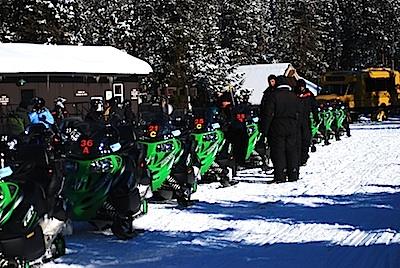Yellowstone National Park's latest winter-use management plan has drawn measured approval from two groups that had been concerned that its draft version was too weak to adequately protect the park's resources.
“There’s much to celebrate here. The park is going to require higher standards for both snowmobiles and snowcoaches," Rick Smith, a member of the Coalition of National Park Service Retirees, said after reviewing the Record of Decision released Thursday.
Under the plan, which won't take effect until the winter of 2014-15, a group of 10 snowmobiles would be seen as one "transportation event" instead of 10 snowmobiles entering the park.
The plan would allow up to 110 transportation events per day; these events are defined as a group of seven snowmobiles or one snowcoach. However, the seven-snowmobiles-per-event would be the seasonal average; there could be times when as many as 10 snowmobiles are packaged in one group. Up to 50 of these events could involve groups of snowmobiles.
By clustering snowmobilers in groups of 7-10 machines, overall noise should be reduced across the park since it wouldn't be spread out across the Grand Loop, proponents say.
“I think a large part of why we can live with the idea of a 'transporation event' vs. a cap on a number of vehicles is the noise issue. It's a huge issue in the park," said Kristen Brengel, senior director of legislative and government relations for the National Parks Conservation Association. "Trying to figure out the best way to minimize it, I think the park has made a strong case for it. Especially ratcheting down the decibel limit per snowmobile to 67 is huge.”
How best to manage recreational snowmobile and snowcoach traffic in the world's first national park has been debated, and litigated, for over a decade, with related costs to the National Park Service estimated at more than $10 million.
The latest plan is far removed from the proposal in 2008 that a federal judge tossed out, saying bluntly that while the National Park Service Organic Act does call for public enjoyment of the national parks, "(T)his is not blanket permission to have fun in the parks in any way the NPS sees fit."
“This winter use plan is the product of hundreds of hours of public involvement, is based on sound science, and is a different approach to winter use management," Yellowstone Superintendent Dan Wenk said in a prepared statement Thursday. "The Plan/SEIS and ROD provide mechanisms to make the park cleaner and quieter than ever before authorized, allow greater flexibility for commercial tour operators, reward oversnow vehicle innovations and technologies, and permit increases in visitation.”
Not everything in the plan pleased the Coalition and NPCA.
“Would we have liked to see fewer transporation events and fewer vehicles per transporation event? Absolutely, because we do think that snowcoaches provide the Park Service better options in terms of visitor experience and reducing some of the impacts we see in the park," Ms. Brengel said. "But they have a defensible alternative here.”
“There are a couple of things that are regrettable in my judgment," added Mr. Smith. "One is that Sylvan Pass is still open, regrettable for three reasons. One, even the revised cost figures for what it costs to keep the pass open in the winter are way too high for the small number of visitors that enter through the East Entrance. Second of all, it’s dangerous for the rangers to do the avalanche control. And the third thing is that unexploded ordnance, which is the inevitable result of using the control methods that they’re using, in the world’s first national park seems to me to be the very oppositie of what we should be doing in a national park."
Mr. Smith, who during his lengthy Park Service career served a stint as Yellowstone's acting superintendent, also was disappointed that "best available technology" standards won't be required for snowmobiles until 2017.
“I think that it could have been better," he said in summation. "But it certainly has been a lot worse in the past. Congratulations to Superintendent Wenk and his staff for coming up with a plan that at least addresses a lot of the concerns that many of us had about previous plans.”


 Support Essential Coverage of Essential Places
Support Essential Coverage of Essential Places







Comments
Hats off to Rick Smith and all the others who helped roll this giant boulder further up the mountain! Cries out for a caption contest under the classic cartoon...
$10+ Million for planning is about the same as the annual operating budget for a medium-sized park. How long will this plan be in effect? Are there revision provisions?
Bombing Sylvan Pass is crazy and the BAT implementation schedule seems a bit lazy. Still, I agree with Rick that this plan is an improvement over previous efforts. I suppose better is the new good since the parks were captured by the pork-barrel politicians.